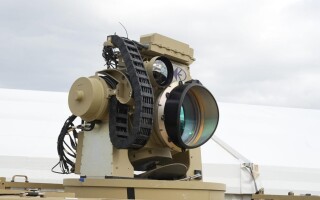DNA marking for counterfeit parts: problem solver or money pit?
StoryDecember 17, 2013
Counterfeit Integrated Circuits (ICs) in the military supply chain that make their way into a weapon system or the avionics of a jet fighter can cause loss of life. Government and industry spend millions of dollars every year to mitigate against counterfeit components entering their supply lines, but it's still a serious threat.
Counterfeits – not counterfeit currency, mind you – but counterfeit Integrated Circuits (ICs) in the military supply chain that make their way into a weapon system or the avionics of a jet fighter can cause loss of life. Government and industry spend millions of dollars every year to mitigate against counterfeit components entering their supply lines, but it’s still a serious threat. These shady parts are very easy to acquire, you can just go to sites like www.chinaicmart.com and get whatever you like. In most cases they look exactly like legitimate parts, but have not been tested or qualified according to military standards.
While everyone – Department of Defense (DoD) and industry alike – want to stop these parts from making their way into systems, disagreements still exist on how it’s done. Controversy is swirling around the Defense Logistics Agency’s (DLA’s) use of Deoxyribonucleic Acid (DNA) marking from a company called Applied DNA Sciences in Stony Brook, NY. DNA is a special ink for marking Federal Supply Class (FSC) 5962 IC parts as authentic. The DNA ink is a DLA requirement established through the Defense Logistics Acquisition Directive, says DLA spokeswoman Michelle McCaskill.
The DLA claims this initiative increases competition and enables more protection against counterfeits, while some industry players say it is a classic example of wasteful spending by the government. Accusations of wasteful spending in an era of budget cuts are worth a closer look.
The controversy
Aftermarket suppliers Lansdale Semiconductor in Tempe, AZ, and Rochester Electronics in Newburyport, MA, claim that the DNA process doesn’t really stop counterfeits, just marks the component as being non-counterfeit – something Original Component Manufacturers (OCMs) already do. The use of DNA equipment is increasing costs to DLA by as much as 40 percent, says Lee Mathiesen, Operations Manager at Lansdale Semiconductor. Millions of taxpayer dollars are being wasted marking parts already authorized as authentic as a way to work with non-authorized brokers of ICs, he adds.
If the government buys from the OCMs they will have no issue with counterfeits so why impose rules on everyone so you can buy form unauthorized sources, says Paul Gerrish, Co-President of Rochester Electronics. Buying from brokers is still risky even if they employ DNA marking “as they do not have to follow the same rules for product storage and manufacturing as do authorized OCMs. It is an unnecessary risk,” he adds. Rochester Electronics has decided against using DNA, Gerrish says.
Lansdale will use the ink to continue selling to the DLA, Mathiesen says. Compliance with DNA requires an equipment investment, but the government is paying for it, not the suppliers. The only thing it’s really costing Lansdale “is time,” he adds. Aside from opening parts up and looking at the process die under close examination the only way to avoid using counterfeit parts is to buy from authorized OCMs like Lansdale and Rochester, Mathiesen says.
DLA responds
DLA officials admit that costs are high with the initial investment in the technology, but over the long run they say costs will go down and create a more competitive marketplace with more players, reducing the expense to taxpayers. The DNA marking would provide a way to work with the independent brokers and still hold them accountable and ensure the use of authentic components, they say.
“DLA believes that costs would rise, especially in the initial phases of adopting the requirement,” McCaskill says. “However, DLA believes the costs will decrease over time and be relatively insignificant as greater adoption of the technology and increased competition occurs.” DLA also gives a supplier the option to mark in-house, or use a third party to mark on their behalf, she adds. The DLA currently has 27 suppliers that DNA mark – nine are OCMs, three are major defense contractors, and 14 are DLA approved distributors, she continues. “The number of participating suppliers is increasing and resulting in better mitigation of vulnerabilities in the DoD supply chain.”
Countering the claim that DNA doesn’t prevent counterfeiting, DLA responded by saying that as part of their research and development efforts on this project they engaged a large nonprofit research and development laboratory to attempt to defeat the technology. “Those defeat efforts were not successful,” McCaskill says. “To date, DNA marking has proven uncopyable and it allows for multiple levels of in-field screening and forensic authentication.” She added that this was part of “an 18-month research and development project also identified 100 percent of DNA-marked product at various nodes in the supply chain and accepted no false positives.”
Mathiesen and Lansdale President Dale Lillard are also concerned that using the ink technically alters the part, which they say will require it to be re-qualified and potentially given a different part number – according to the letter of the regulations. Lansdale’s executives say all 5962 qualified OCMs on MIL-PRF-38535 disagree with DLA’s interpretation in their response below.
In response to this claim the DLA spokeswoman says “the marking does not alter the part and require re-qualification as Lansdale claims. SigNature DNA may be applied in a component substrate or as a marking added post-production. DLA does not believe the post-production mark necessarily requires re-qualification or that it meets the criteria as a form of remarking or rebranding. Adding an additional mark does not by itself constitute remarking, and such action does not cause all additional testing that may be related to marking to be invoked. Using MIL-PRF-38535 as a basis, a manufacturer which adds a DLA-compliant DNA mark may need, as a consequence of the addition, to conduct certain testing only, such as a Resistance to Solvents test. For example, MIL-PRF-38535, A.3.6, ‘Marking of microcircuits’ addresses that after the manufacturer marks the part, the marking must be legible, complete, and shall meet the resistance to solvents requirements test method 2015.”
Smarter spending
DLA has proof that DNA marking can’t be copied, and the initiative will bring more players into the marketplace – all good things – but as with anything it comes back to the money. Specifically the cost to set up companies with DNA marking technology and the cost of the license fee to Applied DNA Sciences, which according to Lansdale, is about $50,000 – or $1,350,000 yearly that the government has to reimburse the suppliers for before they take into ink and labor costs. While the DLA will reimburse companies for this expense, it still doesn’t sufficiently explain whether it is necessary or not to fund that equipment for suppliers who already produce authentic products.
Lansdale’s Mathiesen has a solution to this problem that makes financial sense. He suggests only requiring the independent brokers to use DNA marking and not the authorized OCMs, which already have competent anti-counterfeit policies in place. That argument seems to make economical sense to me, especially in times when many military programs, bases, and laboratories are cutting costs and reducing personnel wherever they can to deal with sequestration and congressional budget cuts. So I asked the DLA why they are spending so much money in this budget-cutting environment to mark authorized OCM products as non-counterfeit if they are already proven to be authentic?
In response DLA officials made the competition argument again and say it is only fair to apply the rules equally to all suppliers. “DLA acquisition policies encourage competition in the marketplace, while ensuring that conforming product is provided to the warfighter,” McCaskill says. “There is a spectrum of product required, and no OCM provides all of it (even if DLA could simply sole-source such procurements). For this reason, the sourcing and qualifications attributes for various types of entities doing business with DLA and being a trusted supplier of FSC 5962, Electronic Microcircuits, are established and consistently applied.”
I get the government’s argument that increased competition will drive costs down and applying rules equally to each supplier has an element of fairness. However, smart, responsible spending will reduce costs as well while providing fairness to the taxpayer. If you are going to require DNA marking, be smart about how you implement it – mark the parts that need it, not ones that don’t.





